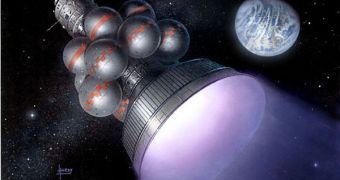Speaking at the 100-Year Starship Symposium held over the weekend, researchers drew attention to some of the challenges associated with multi-generation, long-term space exploration. One of these issues is human reproduction, since the spacecraft's population would have to be replenished in space.
Reaching an exoplanet in orbit around a nearby star would take decades at currently-available speed levels. If humanity is to explore these worlds, and to establish bases there, then sacrifices have to be made, in the form of crews that will leave Earth, but never get to see their destination.
Microgravity is especially hard on the human body, leading to a host of problems such as lower bone and muscle mass, cardiovascular issues and so on. Keeping the crew alive for years is challenging enough by itself, without having to take reproduction into account as well.
Still, Massachusetts Institute of Technology (MIT) expert Dan Buckland said at the conference on September 30, this aspect needs to be factored in as well. The meeting was organized by the US Defense Advanced Research Projects Agency (DARPA).
The agency is working with NASA on the so-called 100-Year Starship Program, which seeks to develop a spacecraft capable of traveling to other stars and planets within this century, Space reports.
What's clear at this point is that a journey to such a place would require dozens, if not hundreds, of years of spaceflight. “It is still unknown, if you want kids and you want reproduction, what gravity has to do with successful development,” Buckland explained.
“The distances to the stars at vast. Large starships will have to be self-sustainable. We don't have such technology yet,” added University of Massachusetts Medical School biologist Athena Andreadis. The nearest star is located about 4 light-years away, or 24 trillion miles (40 trillion kilometers).
The key to a healthy crew over such distances is to create artificial gravity somehow. One possible approach is to construct the entire spacecraft as a giant centrifuge, constantly spinning around a central axis. The centrifugal forces could emulate gravity to some extent.
This is absolutely necessary if children are to be conceived in microgravity. Normal embryonic development could be severely impaired by low gravity, both physically and mentally. Bone and blood density could decrease below acceptable levels, causing numerous problems later in life.
Additional challenges include the dangers of diseases killing entire crews, psychological breakdowns due to tremendous stress and constant pressure, the issue of terraforming new worlds and so on.

 14 DAY TRIAL //
14 DAY TRIAL //